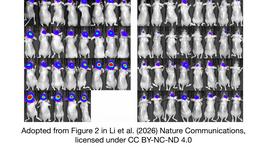CMN Weekly (6 September 2024) - Your Weekly CRISPR Medicine News
By: Gorm Palmgren - Sep. 6, 2024
CMN Intelligence - The World’s Most Comprehensive Intelligence Platform for CRISPR-Genomic Medicine and Gene-Editing Clinical Development
Providing market intelligence, data infrastructure, analytics, and reporting services for the global gene-editing sector. Read more...
Top picks
- Metagenomi reports that its preclinical study of MGX-001, a CRISPR-Cas-based therapy for haemophilia A, has demonstrated durable FVIII activity in non-human primates over 12 months. The treatment, which uses AAV and lipid nanoparticles for gene editing, showed promising safety and efficacy, potentially leading to a one-time curative treatment for haemophilia A.
Research
- Researchers at Cellectis have demonstrated enhanced efficacy in preclinical models of a multi-layered CAR T cell engineering strategy targeting triple-negative breast cancer (TNBC). Using TALEN technology, MUC1 CAR T cells were modified with PD1 and TGFBR2 knockouts and interleukin-12 release to improve function in the immunosuppressive tumour microenvironment. Intratumoral administration reduced both local and distant tumours, retaining antigen-recognition benefits at metastatic sites.
- Italian scientists have demonstrated the potential of a targeted CRISPR-Cas9 delivery system to suppress tumour growth and metastasis in prostate cancer (PC). By employing lipid nanocomplexes conjugated with anti-prostate stem cell antigen (PSCA) antibodies, the researchers delivered the CRISPR-Cas9 system targeting the immunosuppressive interleukin-30 (IL30) gene specifically to PC cells.
- Researchers have generated a Slc26a4 exon-skipping mouse model using CRISPR-Cas9 to mimic the SLC26A4 c.919-2A>G mutation linked to hearing loss. While reframed pendrin expression in the inner ear restored normal vestibular function, hearing did not improve, with cochlear hair cell loss and high hearing thresholds persisting. These findings suggest that alternative genetic editing approaches are needed to effectively treat hearing loss caused by SLC26A4 mutations.
- A study by researchers at Tel Aviv University introduces new predictive features based on codon usage bias (CUB) and gene expression that significantly improve the accuracy of CRISPR efficiency predictions. By incorporating these features into existing predictive models, the study enhances the models’ ability to forecast the effectiveness of CRISPR editing across different cell types.
- Researchers investigating Listeria isolates found 15 new anti-CRISPR (Acr) gene families, which inhibit CRISPR-Cas immunity, often through Cas protein co-option. Notably, one homologue of type I-B Cas protein unexpectedly inhibited the RNA-targeting type VI system by degrading crRNA. A broad-spectrum Cas3 homologue was also identified, inhibiting multiple CRISPR systems.
Industry
- YolTech Therapeutics has received FDA Rare Pediatric Disease Designation for YOLT-203, an in vivo gene editing therapy for treating Primary Hyperoxaluria Type 1 (PH1). Using YolTech’s YolCas12™ CRISPR-Cas system, YOLT-203 targets the HAO1 gene to reduce harmful oxalate buildup in the kidneys. Last week, we reported that the first two patients had been dosed in a Phase 1 trial of YOLT-203.
- ERS Genomics and Medicines Discovery Catapult (MDC) have signed a non-exclusive licence, granting MDC access to ERS’s CRISPR-Cas9 patent portfolio. This partnership enhances MDC’s drug discovery capabilities by integrating gene editing into its research, enabling faster and more efficient development of new therapies.
- Chroma Medicine presented preclinical data on its PCSK9-targeted epigenetic editor at the 2024 European Society of Cardiology Congress. The data show potent, durable reductions in PCSK9 and LDL cholesterol levels without DNA cutting in non-human primates, achieving 68% lower LDL-C for up to three months.
- Caribou Biosciences has received FDA Fast Track designations for its CRISPR-edited CAR-T therapies CB-010 and CB-012. CB-010 targets refractory systemic lupus erythematosus and will enter Phase 1 trials by late 2024, while CB-012, aimed at relapsed or refractory acute myeloid leukaemia, is in ongoing trials. Both therapies offer off-the-shelf treatment options for conditions with significant unmet needs, potentially accelerating their path to approval.
- Precision BioSciences announced the maturity of a $13 million convertible note from its agreement with Imugene for azercabtagene zapreleucel (azer-cel), receiving $9.75 million in cash and $3.25 million in Imugene shares. This bolsters Precision’s balance sheet, supporting Phase 1 data generation for in vivo gene editing programs by mid-2025.
CRISPR screens
- A CRISPR-Cas9 screen comparing 2D cell cultures and xenografts identified MEN1 as a key gene with tumour microenvironment-dependent effects. MEN1 knockout showed no impact on in vitro proliferation but altered tumour growth in mice, promoting growth in immunodeficient and inhibiting it in immunocompetent models. Mechanistically, MEN1 loss activated immune pathways by redistributing MLL1 and H3K4me3, enhancing immune cell infiltration and inhibiting the menin-MLL interaction reduced tumour growth, highlighting MEN1 as a potential target in solid cancers.
Detection
- Scientists in China present a CRISPR-based microfluidic platform that rapidly and sensitively detects viable Escherichia coli O157:H7 in food samples, delivering results in as little as 5 minutes. By using propidium monoazide to exclude dead cells and a direct lysis method, it achieves a detection limit of 36 CFU/mL within 30 minutes, offering a promising tool for food safety testing.
- A Chinese study presents a CRISPR-Cas13a-based transistor biosensor for rapid, highly selective detection of single nucleotide variants (SNVs) in viral RNA. By leveraging engineered crRNA and graphene channels, the biosensor detects RNA without amplification, achieving a detection limit of 5 copies in 100 μL. It discriminates between wild-type and SNV RNA in 15 minutes, offering a sensitive, field-deployable tool for viral diagnostics, including influenza and SARS-CoV-2 variants.
Reviews
- Harnessing cellular therapeutics for type 1 diabetes mellitus: progress, challenges, and the road ahead. This review maps the progress in cell replacement therapies for T1DM and outlines the remaining challenges and future directions.
- Role of CRISPR-Cas systems in periodontal disease pathogenesis and potential for periodontal therapy: A review. This review discusses the roles of CRISPR-Cas systems in oral microbes, their involvement in periodontal disease pathogenesis, and potential applications in precision periodontal therapy.
- An evaluation of exagamglogene autotemcel for the treatment of sickle cell disease and transfusion-dependent beta-thalassaemia. This review discusses the safety, efficacy, and clinical outcomes of using CRISPR-Cas9 gene therapy to increase fetal haemoglobin levels in patients with sickle cell disease and beta-thalassemia, comparing it to other curative treatments.
Commentaries
- In their latest post, WeDoCRISPR shares a handy schematic to help you remember what the major gene-editing technologies can be used for. This could be a good one to print out and use as a bookmark!
News from CRISPR Medicine News
- On Monday, we brought an interview with scientists from Profluent Bio, who have used AI to expand the sequence diversity of CRISPR-Cas proteins and generate novel, functional genome editors with improved properties compared to natural systems. This novel AI-based approach for designing CRISPR gene editors could potentially expand the capabilities and applications of genome-editing technologies.
This article was originally published on 6th September 2024. In the original publication, the AGXT gene was incorrectly stated as the target for YOLT-203. The target of YOLT-203 is the HAO1 gene. The article was updated to include this correction on 26th February 2025.
To get more CRISPR Medicine News delivered to your inbox, sign up to the free weekly CMN Newsletter here.
Tags
CLINICAL TRIALS
IND Enabling
Phase I
Phase II
Phase III
Gastric Cancer and Colorectal Cancer, CRC, (NCT07166263)
Sponsors:
Base Therapeutics (Shanghai) Co., Ltd.
Sponsors:
Base Therapeutics (Shanghai) Co., Ltd.
IND Enabling
Phase I
Phase II
Phase III
Relapsed or Refractory Acute Myeloid Leukemia, AML, (NCT06541444)
Sponsors:
Base Therapeutics (Shanghai) Co., Ltd.
Sponsors:
Base Therapeutics (Shanghai) Co., Ltd.
IND Enabling
Phase I
Phase II
Phase III







